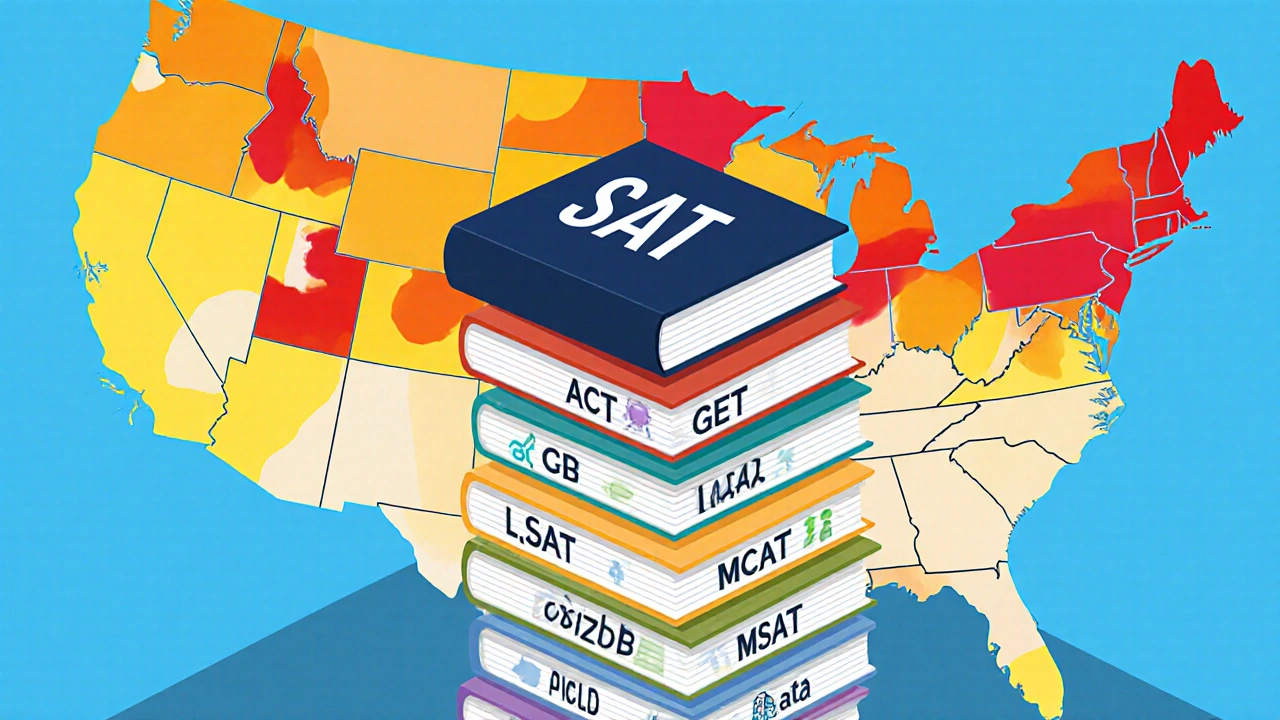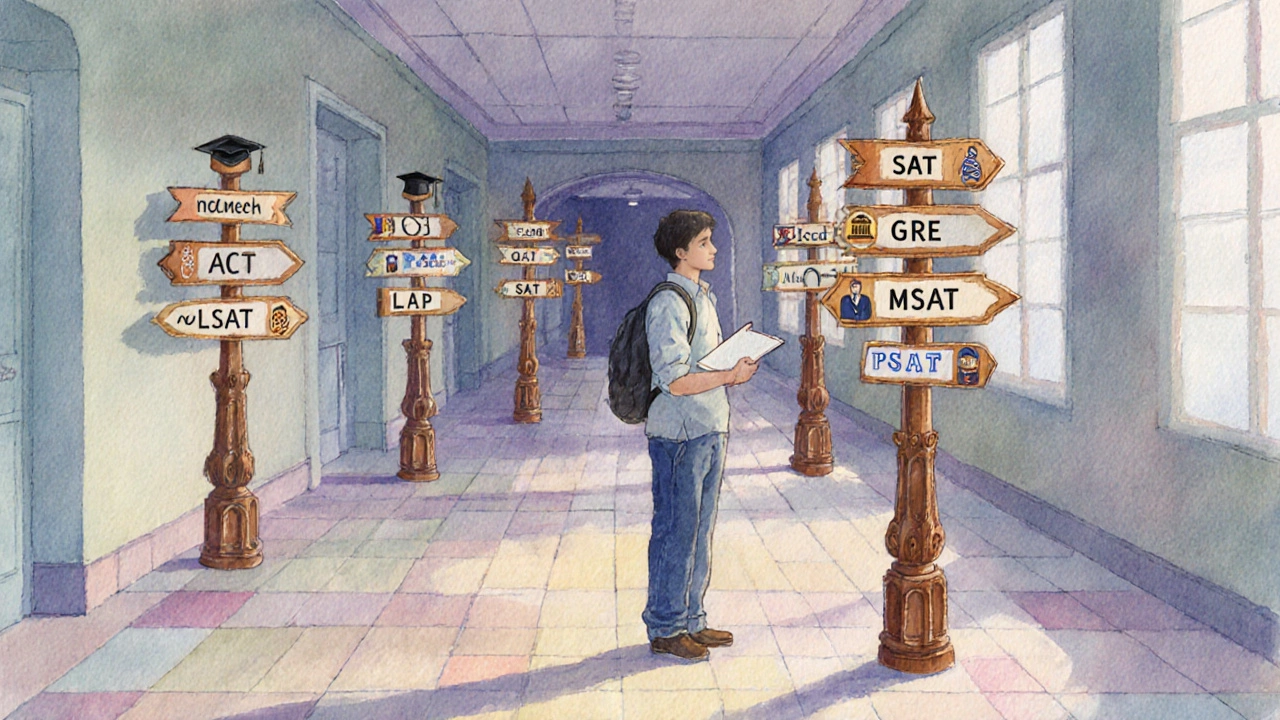SAT vs ACT Selection Guide
Which Exam is Right for You?
This tool helps you choose between the SAT and ACT based on your strengths, college goals, and preferences.
When you hear people talk about the most popular US exam, the answer isn’t always obvious. Hundreds of standardized tests are taken each year, but only a few dominate the headlines and the test‑center queues. This article breaks down the numbers, explains why one test leads the pack, and helps you understand what the data mean for students and educators.
Key Takeaways
- The SAT consistently records the highest annual test‑taker count among U.S. standardized exams.
- College admissions tests (SAT, ACT) together make up more than half of all test‑takers.
- Trends like test‑optional policies are reshaping participation rates, but the SAT still edges out competitors.
- Choosing the right exam depends on your college goals, subject strengths, and timing.
- We provide a quick comparison table and a FAQ to answer the most common follow‑up questions.
How We Measure Exam Popularity
Popularity can be looked at from several angles. For this guide we focus on three hard‑data points:
- Annual test‑taker volume - the number of individuals who sit for the exam in a given year.
- Public awareness - how often the exam appears in media, college brochures, and online searches.
- Institutional reliance - the percentage of colleges that list the exam as a required or recommended credential.
By combining these metrics we get a clear picture of which exam truly captures the nation’s attention.
Top U.S. Exams by Test‑Taker Volume (2024 Data)
The numbers below come from official reports published by the testing agencies and from the College Board’s annual testing statistics.
| Exam | Annual test‑takers (approx.) | Primary purpose | Typical score range |
|---|---|---|---|
| SAT | 2.2 million | College admissions | 400 - 1600 |
| ACT | 1.9 million | College admissions | 1 - 36 (composite) |
| GRE | 500 thousand | Graduate school entry | 130 - 170 (verbal & math), 0 - 6 (writing) |
| Advanced Placement (AP) Exams | ≈ 6 million (total exams taken) | College credit in high school | 1 - 5 |
| LSAT | ≈ 100 thousand | Law school admission | 120 - 180 |
| MCAT | ≈ 75 thousand | Medical school admission | 472 - 528 |
| US citizenship test | ≈ 80 thousand | Naturalization interview | 0 - 100 % (score) |
| PSAT/NMSQT | ≈ 2 million | College readiness & scholarship qualifier | 320 - 1520 (combined) |
Deep Dive: SAT - The Clear Leader
SAT is a college‑admissions exam administered by the College Board that tests reading, writing, and math skills of high‑school seniors. In 2024 the test saw 2.2 million participants, a slight dip from previous years but still well ahead of any rival.
The SAT’s dominance comes from a few factors:
- Long history: first introduced in 1926, it’s deeply embedded in college‑selection processes.
- Broad acceptance: over 1,500 U.S. colleges list the SAT as a preferred score.
- Extensive prep ecosystem: countless books, online courses, and tutoring services focus on the SAT, making it the most familiar test for students.

Deep Dive: ACT - The Main Challenger
ACT is a college‑admissions test created by ACT, Inc. that evaluates English, math, reading, and science reasoning. The ACT’s 2024 participation of about 1.9 million makes it the second‑largest exam in the U.S. market.
Why the ACT isn’t the top dog yet:
- It’s more popular in the Midwest and South, while the SAT retains a stronger presence on the coasts.
- Fewer preparatory resources historically, though that gap is closing fast.
Other Widely Taken Exams
GRE is a graduate‑school entrance exam offered by ETS that measures verbal reasoning, quantitative reasoning, and analytical writing. About half a million candidates sit for it each year, mostly for master’s and PhD programs.
Advanced Placement (AP) Exams are college‑level courses and exams administered by the College Board that can earn high‑school students college credit. While each student may take a handful, the total number of AP exams administered exceeds six million annually.
LSAT is a law‑school admission test that assesses reading comprehension, analytical reasoning, and logical reasoning. Roughly 100 k examinees each year target law school enrollment.
MCAT is the Medical College Admission Test, a standardized exam for prospective medical students covering biological, chemical, and physical foundations. About 75 k candidates sit for the MCAT annually.
US citizenship test is a civics exam taken during the naturalization interview, covering U.S. history and government. Roughly 80 k immigrants take this test each year.
PSAT/NMSQT is a preliminary SAT that also serves as a qualifier for the National Merit Scholarship Program. Its 2024 participation peaked at about 2 million, but it’s considered a practice test rather than a final admission score.
Why the SAT Still Leads
Even with the rise of test‑optional policies, the SAT’s infrastructure keeps it ahead:
- Scale: The College Board runs thousands of testing centers nationwide.
- Data tracking: Detailed score reports give colleges granular insight into applicant readiness.
- Brand recognition: High‑school guidance counselors often default to the SAT when discussing college prep.
All these factors create a self‑reinforcing cycle: more students take the SAT because colleges expect it, and colleges expect it because most students are already sitting for it.
Recent Trends Shaping Exam Participation
The testing landscape isn’t static. Two major trends have emerged in the last few years:
- Test‑optional movement: Over 1,200 colleges announced test‑optional policies after the pandemic, causing a dip in SAT/ACT registrations in 2022‑2023. However, many elite schools still request scores for scholarship consideration, pulling the numbers back up.
- Digital testing: Both the SAT and ACT now offer fully computer‑based versions, boosting accessibility in rural areas and reducing test‑day anxiety for many students.
These shifts may gradually level the playing field, but the SAT’s sheer volume keeps it at the top for now.

Choosing the Right Exam for Your Goals
If you’re a high‑school student wondering which test to prioritize, consider these quick questions:
- Which colleges are you targeting? Some schools still list a preference for SAT or ACT scores.
- What are your strengths? The ACT includes a science reasoning section; the SAT leans more on evidence‑based reading and math.
- Do you need a scholarship? National Merit eligibility depends on PSAT scores, which mirror the SAT format.
- When can you fit prep into your schedule? The SAT has a larger pool of free resources and official practice tests.
In most cases, taking both the SAT and ACT once each provides a safety net, letting you submit the higher score to colleges.
Quick Reference Checklist
- Most popular exam: SAT (2.2 M test‑takers, 2024)
- Second place: ACT (1.9 M)
- Graduate‑level leader: GRE (0.5 M)
- College‑credit leader: AP Exams (≈ 6 M total exams)
- Key trend: Test‑optional policies are causing modest dips but not overturning SAT dominance
Frequently Asked Questions
Which exam should I take if I want to apply to Ivy League schools?
Ivy League schools accept both SAT and ACT scores. Most applicants submit the higher of the two, so it’s wise to try both if time permits. Strong SAT scores often open doors to merit‑based scholarships.
Has the SAT’s popularity declined since the test‑optional wave?
There was a noticeable dip in 2022‑2023, but many colleges still request scores for scholarships and competitive programs. The 2024 figures show the SAT rebounding to roughly 2.2 million test‑takers.
Is the ACT easier than the SAT?
Ease is subjective. The ACT includes a science reasoning section and is slightly shorter, while the SAT emphasizes evidence‑based reading. Try practice tests for both to see which format matches your strengths.
Do graduate schools look at SAT or ACT scores?
Generally no. Graduate programs focus on the GRE, GMAT, LSAT, or MCAT, depending on the field. Undergraduate SAT/ACT scores might be considered for scholarship eligibility, but they’re not a primary factor.
How can I prepare for the SAT on a budget?
Use the free official practice tests on the College Board website, watch YouTube tutorial series, and join free study groups on platforms like Reddit or Discord. Libraries often carry SAT prep books you can borrow.
Next Steps
Now that you know the SAT holds the top spot, decide which exam aligns with your college plan. Register early for a test date, grab an official practice test, and set a study schedule that fits your routine. If you’re still unsure, talk to your school counselor - they can help you interpret score requirements for your target schools.
